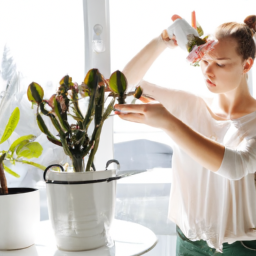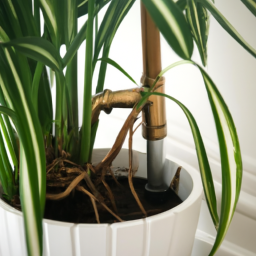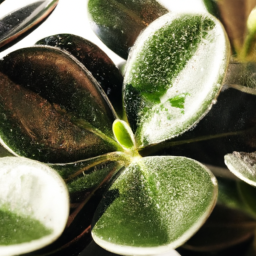
Have you ever experienced a headache that seemed to come out of nowhere? If so, you may have wondered if your indoor plants could be the culprit. In this blog post, we will explore the question, “Can indoor plants cause headaches?” Many people believe that plants can improve indoor air quality and overall well-being, but could they also be contributing to your headache? Let’s delve into the research and find out the truth behind this common concern.
Effects of Indoor Plants on Indoor Air Quality
Can Indoor Plants Cause Headaches?
Indoor plants are a popular choice for adding greenery and life to indoor spaces. However, some people may experience headaches when they are around indoor plants. This can be due to a variety of factors, including the type of plant, the environment it is in, and individual sensitivities.
One possible reason indoor plants can cause headaches is due to the release of volatile organic compounds (VOCs). VOCs are chemicals that can be emitted by plants as they grow and interact with their environment. Some people may be sensitive to these chemicals, which can lead to symptoms such as headaches, dizziness, and nausea.
In addition to VOCs, indoor plants can also release pollen and other allergens that can trigger headaches in sensitive individuals. If you have allergies or asthma, you may be more prone to experiencing headaches when exposed to indoor plants.
Another factor to consider is the presence of mold and mildew in the soil of indoor plants. Mold spores can be released into the air and cause respiratory symptoms, including headaches. It is important to regularly check and maintain the soil of your indoor plants to prevent mold growth.
How to Minimize the Risk of Headaches from Indoor Plants
If you suspect that indoor plants are causing your headaches, there are steps you can take to minimize the risk. One option is to choose plants that are known to have low emissions of VOCs, such as spider plants, peace lilies, and snake plants. These plants are also relatively easy to care for, making them a great choice for indoor spaces.
Another way to reduce the risk of headaches from indoor plants is to improve ventilation in your home. Opening windows and using fans can help to circulate air and reduce the concentration of VOCs and allergens in the air. Additionally, using an air purifier can help to filter out pollutants and improve indoor air quality.
Regularly dusting and cleaning the leaves of your indoor plants can also help to reduce the buildup of allergens and dust that can contribute to headaches. Keeping your plants well-watered and maintaining proper humidity levels can also help to prevent mold growth and reduce the risk of respiratory symptoms.
Conclusion
While indoor plants can provide many benefits, including improving air quality and reducing stress, some people may experience headaches when exposed to indoor plants. By choosing plants with low emissions of VOCs, improving ventilation, and maintaining your plants properly, you can minimize the risk of headaches and enjoy the beauty and benefits of indoor plants.
It is important to pay attention to how you feel when around indoor plants and make adjustments as needed to create a healthy and comfortable indoor environment. If you continue to experience headaches despite taking these steps, it may be a good idea to consult with a healthcare professional to rule out any underlying health issues.
Remember, indoor plants should enhance your living space, not detract from it. With a little care and attention, you can enjoy the beauty of indoor plants without the headache.

Can Indoor Plants Cause Headaches?
As an expert on indoor plants and their effects on health, I can tell you that while indoor plants are generally good for air quality and overall well-being, there are certain plants that can potentially trigger headaches in some individuals. It’s important to be aware of these plants and their potential effects, especially if you are prone to headaches or migraines.
Common Indoor Plants that Can Trigger Headaches
1. Peace Lily
The Peace Lily is a popular indoor plant known for its beautiful white flowers and air-purifying properties. However, it can also be a trigger for headaches in some people. The Peace Lily produces pollen and floral scents that can irritate sensitive individuals, leading to headaches or other allergic reactions. If you are prone to headaches, it may be best to avoid keeping a Peace Lily in your home or office.
In addition to its potential to trigger headaches, the Peace Lily is also toxic to pets if ingested. It’s important to keep this plant out of reach of children and animals to avoid any potential poisoning incidents.
Overall, while the Peace Lily is a beautiful and beneficial plant for air quality, it may not be the best choice for individuals who are sensitive to its pollen and scents.
2. Snake Plant
The Snake Plant, also known as Mother-in-Law’s Tongue, is another popular indoor plant that can potentially trigger headaches in some individuals. This plant is known for its easy care and air-purifying properties, making it a common choice for indoor spaces.
However, the Snake Plant releases oxygen at night, which can lead to an increase in humidity levels in the room. This rise in humidity can sometimes trigger headaches in individuals who are sensitive to changes in air quality. If you find that you are experiencing headaches or other symptoms when the Snake Plant is in your home, you may want to consider moving it to a well-ventilated area or limiting the number of plants in your space.
While the Snake Plant is generally considered safe for most individuals, it’s important to be aware of its potential to trigger headaches in some people. If you are sensitive to changes in air quality, it may be best to choose a different plant for your indoor space.
3. English Ivy
English Ivy is a classic indoor plant known for its trailing vines and ability to purify the air. However, this plant can also be a trigger for headaches in some individuals. English Ivy produces a strong scent that can be irritating to sensitive individuals, leading to headaches or other respiratory issues.
If you find that you are experiencing headaches or other symptoms when English Ivy is present in your space, it may be best to consider moving it to a well-ventilated area or choosing a different plant altogether. While English Ivy is a beautiful and beneficial plant, it may not be the best choice for individuals who are sensitive to its scent.
Overall, while indoor plants can provide numerous benefits for air quality and overall well-being, it’s important to be aware of the potential triggers for headaches in certain individuals. By choosing the right plants for your space and being mindful of any symptoms you may experience, you can create a healthy and headache-free indoor environment.

Can Indoor Plants Cause Headaches?
As an expert in indoor plants and their effects on health, I can confidently say that yes, indoor plants can indeed cause headaches in some individuals. While plants are known to have numerous benefits such as improving air quality and reducing stress, certain factors associated with indoor plants can trigger headaches in sensitive individuals.
Potential Causes of Headaches from Indoor Plants
One common factor that can contribute to headaches from indoor plants is the release of volatile organic compounds (VOCs). VOCs are chemicals that are emitted by plants as part of their natural growth process. While most people are not affected by these compounds, some individuals may be sensitive to them and experience headaches as a result.
In addition, mold and mildew growth on indoor plants can also be a potential trigger for headaches. Mold spores can be released into the air and inhaled, leading to respiratory issues and headaches in some individuals. It is important to regularly inspect your indoor plants for any signs of mold or mildew and take steps to prevent their growth.
Lastly, some individuals may be allergic to certain types of indoor plants, which can also lead to headaches. Allergies to pollen, dust, or other plant particles can cause symptoms such as headaches, sneezing, and congestion. If you suspect that your headaches are being caused by an indoor plant allergy, it may be best to remove the plant from your home or relocate it to a different area.
How to Prevent Headaches Caused by Indoor Plants
1. Choose the right plants: When selecting indoor plants for your home, opt for varieties that are known to have low levels of VOC emissions. Plants such as spider plants, snake plants, and peace lilies are excellent choices for improving air quality without triggering headaches.
2. Proper ventilation: To reduce the concentration of VOCs and mold spores in the air, ensure that your home is well-ventilated. Open windows regularly to allow fresh air to circulate and consider using a dehumidifier to control humidity levels and prevent mold growth.
3. Regular maintenance: Keep your indoor plants healthy and free of mold by regularly watering them, removing dead leaves, and dusting their leaves. Pruning plants can also help improve air circulation and prevent the buildup of allergens that can trigger headaches.
By following these tips and being mindful of the potential triggers for headaches from indoor plants, you can enjoy the many benefits of having greenery in your home without experiencing unwanted side effects. Remember to listen to your body and make adjustments as needed to create a healthy and headache-free indoor environment.
Let’s bring it all home
Have you ever experienced a headache that you couldn’t quite pinpoint the cause of? It may surprise you to learn that indoor plants could be the culprit. While plants are typically thought of as beneficial for indoor air quality and overall well-being, certain varieties can release volatile organic compounds (VOCs) that may trigger headaches in sensitive individuals. These compounds, such as formaldehyde and benzene, can be emitted from plant leaves and soil, especially in enclosed spaces with poor ventilation.
If you frequently experience headaches and have indoor plants in your home or workspace, it may be worth considering the types of plants you have and their potential impact on your health. Opting for plants that are known for their air-purifying properties, such as spider plants or peace lilies, can help reduce the risk of VOC exposure and associated headaches. Additionally, ensuring proper ventilation and regularly dusting and watering your plants can also help minimize any potential negative effects. By being mindful of the types of plants you choose and how you care for them, you can continue to enjoy the beauty and benefits of indoor greenery without the risk of headaches.
FAQ Compilation:
Q1: Can indoor plants cause headaches?
A1: Yes, indoor plants can potentially cause headaches in some individuals. Certain plants release volatile organic compounds (VOCs) which can trigger headaches or migraines in sensitive people.
Q2: Which indoor plants are more likely to cause headaches?
A2: Plants such as peace lilies, snake plants, and rubber trees are known to release higher levels of VOCs that may lead to headaches. However, the sensitivity to these compounds varies from person to person.
Q3: How can I reduce the risk of indoor plants causing headaches?
A3: To minimize the risk, consider choosing plants with low VOC emissions such as spider plants, aloe vera, or bamboo palm. Proper ventilation and regular dusting of plant leaves can also help reduce the concentration of VOCs in the air.
Q4: Can proper care and maintenance of indoor plants prevent headaches?
A4: Yes, ensuring that your indoor plants are healthy and well-maintained can reduce the likelihood of them releasing excessive amounts of VOCs. Proper watering, adequate sunlight, and occasional repotting can help keep your plants in good condition.
Q5: What should I do if I suspect my indoor plants are causing headaches?
A5: If you suspect that your indoor plants are triggering headaches, try moving them to a different location or removing them from your living space temporarily to see if your symptoms improve. Consulting a healthcare professional for further advice is recommended if headaches persist.
Dr. Olivia Green is a botanist with over two decades of experience in indoor plant cultivation. She holds a Ph.D. in Plant Biology and has dedicated her career to researching plant behavior in controlled environments. Dr. Green is passionate about helping plant enthusiasts master the art of indoor gardening through her extensive knowledge and practical insights.


